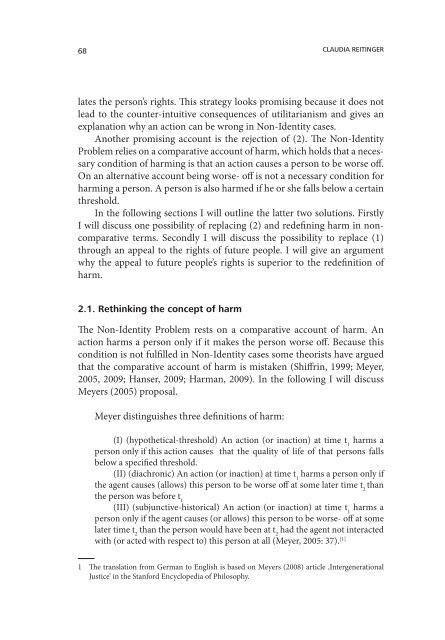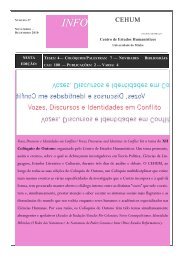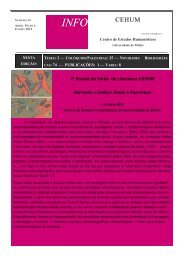- Page 1 and 2:
25/2 revista do centro de estudos h
- Page 3 and 4:
Título: DIACRÍTICA (Nº 25/2 - 20
- Page 5 and 6:
CULTURA INGLESA E NORTE-AMERICANA 1
- Page 7 and 8:
Diacritica 25-2_Filosofia.indb 6 05
- Page 9 and 10:
Diacritica 25-2_Filosofia.indb 8 05
- Page 11 and 12:
10 ALEXANDRA ABRANCHES E ROBERTO ME
- Page 13 and 14:
Diacritica 25-2_Filosofia.indb 12 0
- Page 15 and 16:
14 Introduction BERIL SÖZMEN IDEME
- Page 17 and 18: 16 BERIL SÖZMEN IDEMEN When a fema
- Page 19 and 20: 18 BERIL SÖZMEN IDEMEN example, Th
- Page 21 and 22: 20 BERIL SÖZMEN IDEMEN doubt wheth
- Page 23 and 24: 22 BERIL SÖZMEN IDEMEN Th omson’
- Page 25 and 26: 24 BERIL SÖZMEN IDEMEN If we are t
- Page 27 and 28: 26 BERIL SÖZMEN IDEMEN respect, es
- Page 29 and 30: 28 BERIL SÖZMEN IDEMEN choices tha
- Page 31 and 32: 30 BERIL SÖZMEN IDEMEN Good Samari
- Page 33 and 34: Diacritica 25-2_Filosofia.indb 32 0
- Page 35 and 36: 34 1. Introdução CÁTIA FARIA No
- Page 37 and 38: 36 CÁTIA FARIA Deste modo, chegamo
- Page 39 and 40: 38 CÁTIA FARIA e os orangotangos e
- Page 41 and 42: 40 CÁTIA FARIA temporal, quando no
- Page 43 and 44: 42 CÁTIA FARIA mesmo. “Sem um se
- Page 45 and 46: 44 CÁTIA FARIA soas são seres esp
- Page 47 and 48: 46 CÁTIA FARIA David não é ele p
- Page 49 and 50: 48 7. Resumo e conclusões CÁTIA F
- Page 51 and 52: 50 CÁTIA FARIA Patterson, F. G. e
- Page 53 and 54: 52 CÉDRIC RIO Debates about Interg
- Page 55 and 56: 54 CÉDRIC RIO we are not sure to h
- Page 57 and 58: 56 CÉDRIC RIO ence: individuals ca
- Page 59 and 60: 58 CÉDRIC RIO morally wrong becaus
- Page 61 and 62: 60 CÉDRIC RIO preference for Liber
- Page 63 and 64: Diacritica 25-2_Filosofia.indb 62 0
- Page 65 and 66: 64 1. The problem CLAUDIA REITINGER
- Page 67: 66 CLAUDIA REITINGER Depletion: As
- Page 71 and 72: 70 CLAUDIA REITINGER responses for
- Page 73 and 74: 72 CLAUDIA REITINGER a very high le
- Page 75 and 76: 74 CLAUDIA REITINGER had chosen con
- Page 77 and 78: 76 CLAUDIA REITINGER properties, li
- Page 79 and 80: Diacritica 25-2_Filosofia.indb 78 0
- Page 81 and 82: 80 HASSE HÄMÄLÄINEN que actualme
- Page 83 and 84: 82 HASSE HÄMÄLÄINEN appropriate
- Page 85 and 86: 84 HASSE HÄMÄLÄINEN son cannot b
- Page 87 and 88: 86 HASSE HÄMÄLÄINEN than charact
- Page 89 and 90: 88 HASSE HÄMÄLÄINEN lence” and
- Page 91 and 92: 90 5. A more promising proposal HAS
- Page 93 and 94: 92 HASSE HÄMÄLÄINEN this particu
- Page 95 and 96: Diacritica 25-2_Filosofia.indb 94 0
- Page 97 and 98: 96 MARIA JOÃO CABRITA e o seu rele
- Page 99 and 100: 98 MARIA JOÃO CABRITA a legal ethi
- Page 101 and 102: 100 MARIA JOÃO CABRITA - the inter
- Page 103 and 104: 102 MARIA JOÃO CABRITA justice, in
- Page 105 and 106: 104 MARIA JOÃO CABRITA Rawls seeks
- Page 107 and 108: 106 MARIA JOÃO CABRITA members of
- Page 109 and 110: 108 MARIA JOÃO CABRITA Spiro, Davi
- Page 111 and 112: 110 MARTHA PALACIO AVENDAÑO El obj
- Page 113 and 114: 112 MARTHA PALACIO AVENDAÑO de reg
- Page 115 and 116: 114 2. Cosmopolitismo y derechos hu
- Page 117 and 118: 116 MARTHA PALACIO AVENDAÑO societ
- Page 119 and 120:
118 MARTHA PALACIO AVENDAÑO lo que
- Page 121 and 122:
120 MARTHA PALACIO AVENDAÑO poder
- Page 123 and 124:
122 MARTHA PALACIO AVENDAÑO 126, 2
- Page 125 and 126:
Diacritica 25-2_Filosofia.indb 124
- Page 127 and 128:
126 1. Intransitive preferences OSC
- Page 129 and 130:
128 A 1 > 1 A 2 ; A 2 > 1 A 3 ; ...
- Page 131 and 132:
130 OSCAR HORTA principle obvious.
- Page 133 and 134:
132 5. Possible global solutions to
- Page 135 and 136:
134 OSCAR HORTA between 1 and i suc
- Page 137 and 138:
136 OSCAR HORTA considerably shorte
- Page 139 and 140:
138 7. Conclusions OSCAR HORTA Spec
- Page 141 and 142:
Diacritica 25-2_Filosofia.indb 140
- Page 143 and 144:
142 RUI SILVA inclinations […]; f
- Page 145 and 146:
144 RUI SILVA ble diversity of situ
- Page 147 and 148:
146 RUI SILVA and complement these
- Page 149 and 150:
148 RUI SILVA emotions and virtue;
- Page 151 and 152:
150 RUI SILVA lives should be under
- Page 153 and 154:
152 RUI SILVA However, MacIntyre cl
- Page 155 and 156:
154 RUI SILVA alists concede that s
- Page 157 and 158:
156 RUI SILVA Taylor, Charles (1990
- Page 159 and 160:
Diacritica 25-2_Filosofia.indb 158
- Page 161 and 162:
160 GEORGINA ABREU Th e print cultu
- Page 163 and 164:
162 GEORGINA ABREU that the prosecu
- Page 165 and 166:
164 GEORGINA ABREU stability of the
- Page 167 and 168:
166 GEORGINA ABREU gled out and exp
- Page 169 and 170:
168 GEORGINA ABREU ways. Th is disc
- Page 171 and 172:
170 GEORGINA ABREU Queen’s case:
- Page 173 and 174:
172 GEORGINA ABREU From the point o
- Page 175 and 176:
174 GEORGINA ABREU 1998: 38) that g
- Page 177 and 178:
176 GEORGINA ABREU denounces the co
- Page 179 and 180:
178 GEORGINA ABREU i-ii). Hone, in
- Page 181 and 182:
180 Periodicals GEORGINA ABREU Cobb
- Page 183 and 184:
182 GEORGINA ABREU 1819-1821 Illust
- Page 185 and 186:
184 GEORGINA ABREU Laqueur, T.W.,
- Page 187 and 188:
186 JORGE PEREIRA A Revolução Ame
- Page 189 and 190:
188 JORGE PEREIRA concebidos para e
- Page 191 and 192:
190 JORGE PEREIRA proposta de aboli
- Page 193 and 194:
192 JORGE PEREIRA permitia a todos
- Page 195 and 196:
194 JORGE PEREIRA agora era o Indiv
- Page 197 and 198:
196 JORGE PEREIRA moral já que qua
- Page 199 and 200:
198 JORGE PEREIRA sistas têm defen
- Page 201 and 202:
200 JORGE PEREIRA Homem, daí estar
- Page 203 and 204:
Diacritica 25-2_Filosofia.indb 202
- Page 205 and 206:
204 Recepção musical como mimesis
- Page 207 and 208:
206 ÂNGELO MARTINGO agógicos dos
- Page 209 and 210:
208 Sumário e conclusão ÂNGELO M
- Page 211 and 212:
210 ÂNGELO MARTINGO Grewe, O., Kop
- Page 213 and 214:
212 ÂNGELO MARTINGO Tanenhaus, M.,
- Page 215 and 216:
214 1. Críticas e objeções aos d
- Page 217 and 218:
216 GIUSEPPE TOSI dade das relaçõ
- Page 219 and 220:
218 GIUSEPPE TOSI ocidentais atrav
- Page 221 and 222:
220 GIUSEPPE TOSI Francesa (Compara
- Page 223 and 224:
222 GIUSEPPE TOSI ciências naturai
- Page 225 and 226:
224 GIUSEPPE TOSI que a realidade
- Page 227 and 228:
226 GIUSEPPE TOSI -----, (2006). Te
- Page 229 and 230:
228 I. O argumento JOSÉ COLEN Buch
- Page 231 and 232:
230 JOSÉ COLEN tica numa situaçã
- Page 233 and 234:
232 JOSÉ COLEN mas as outras impli
- Page 235 and 236:
234 JOSÉ COLEN “que modifi cam o
- Page 237 and 238:
236 JOSÉ COLEN unidade orgânica p
- Page 239 and 240:
238 JOSÉ COLEN que a respectiva
- Page 241 and 242:
240 JOSÉ COLEN Um dos fenómenos p
- Page 243 and 244:
242 JOSÉ COLEN Hayek deixou claro
- Page 245 and 246:
244 JOSÉ COLEN rias nos domínios
- Page 247 and 248:
246 JOSÉ COLEN no mercado a motiva
- Page 249 and 250:
248 JOSÉ COLEN Mueller, Dennis C.
- Page 251 and 252:
250 1. Introdução VÍTOR MOURA O
- Page 253 and 254:
252 VÍTOR MOURA phrey Bogart para
- Page 255 and 256:
254 VÍTOR MOURA que o cinema vive
- Page 257 and 258:
256 2) 3) VÍTOR MOURA Redução da
- Page 259 and 260:
258 VÍTOR MOURA fílmica (a vulgar
- Page 261 and 262:
260 3. Câmara: a doutrina da trans
- Page 263 and 264:
262 VÍTOR MOURA máticas dos objec
- Page 265 and 266:
264 VÍTOR MOURA “A fotografi a
- Page 267 and 268:
266 VÍTOR MOURA representações d
- Page 269 and 270:
268 VÍTOR MOURA podemos explicar a
- Page 271 and 272:
270 VÍTOR MOURA Em resumo, poderí
- Page 273 and 274:
272 4.3. Teoria da mente e simulaç
- Page 275 and 276:
274 VÍTOR MOURA ninguém acredita
- Page 277 and 278:
Diacritica 25-2_Filosofia.indb 276
- Page 279 and 280:
Diacritica 25-2_Filosofia.indb 278
- Page 281 and 282:
280 VIRGÍNIA SOARES PEREIRA Gaio V
- Page 283 and 284:
Diacritica 25-2_Filosofia.indb 282
- Page 285 and 286:
284 VIRGÍNIA SOARES PEREIRA No pre
- Page 287 and 288:
Diacritica 25-2_Filosofia.indb 286
- Page 289 and 290:
288 Editor Adjunto: Virgínia Perei
- Page 291 and 292:
290 DIACRÍTICA 3. Os textos das en
- Page 293 and 294:
292 • • • • Imagens Alinham
- Page 295 and 296:
294 Citação indireta: (apud Chand
- Page 297:
The Braga meetings on ethics and po











![Programa [pdf] - cehum - Universidade do Minho](https://img.yumpu.com/17305425/1/190x135/programa-pdf-cehum-universidade-do-minho.jpg?quality=85)




